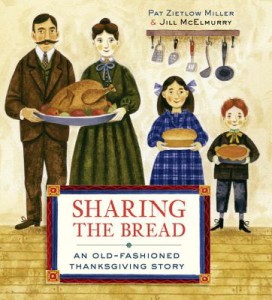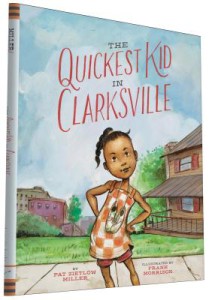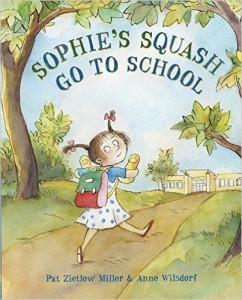It’s a pleasure to welcome back Pat Zietlow Miller to ReaderKidZ to talk about her newest book, SHARING THE BREAD.
Dianne: SHARING THE BREAD is your third book, and what a beauty! The subtitle, “An Old-Fashioned Thanksgiving Story” hints at the traditional and timeless nature of the text. The illustrations – gouache on watercolor paper – beautifully rendered by Jill McElmurry, capture a 19th-century American family preparing the stove and cooking pot, kneading bread and basting a tasty turkey. Yum!
Americans love Thanksgiving. Do you have a favorite tradition associated with the holiday? Maybe the “before” time of prepping food, setting the table, making sure all is ready? Or the quiet “after” time when everyone’s stuffed and talked out?
PAT: I really enjoy Thanksgiving. It’s my favorite holiday. I like all the parts, but my favorite might be eating the leftovers for the next few days. I like turkey sandwiches – chopped turkey on good sourdough bread with a little butter and some salt. And, I like seeing my brother and sister, whom I don’t see nearly enough.
And, may I just say that I’m so impressed with Jill McElmurry’s art in this book? I love how she brings the family to life and all the research she did to reflect the kitchen accurately. Here’s an interview where Jill talks about how she approached the book.
Dianne: From the first page, your lyrical text immediately brought to mind the rhythms of a song. Not a song I knew, but one that I felt might have roots in an old colonial favorite. The pattern of the first line, repeated with a small change in the last line of a stanza. A chorus, that folds in a key word from each of these stanzas, follows. It’s lovely.
 Sometimes the simplest text can be the hardest to write. Other times, the words just seem to pour out. Can you talk about your process in writing SHARING THE BREAD? Did the text come quickly, or was this a story that needed lots of think time? How did you choose the structure? What about the decision to rhyme, which can be a challenge in and of itself?
Sometimes the simplest text can be the hardest to write. Other times, the words just seem to pour out. Can you talk about your process in writing SHARING THE BREAD? Did the text come quickly, or was this a story that needed lots of think time? How did you choose the structure? What about the decision to rhyme, which can be a challenge in and of itself?
PAT: First, thank you for comparing the text to a song. It isn’t something I’d thought of, but an author friend of mine, Lisa Morlock, says her kids came up with a tune and sing the book. This makes me happy on many levels.
The first draft of this book came relatively easily. I heard the first two sentences in my head during a work meeting that had nothing to do with food. I emailed them to myself at home and started playing around with them. Soon, I had a family working together to create a meal.
An editor suggested having the family cook a holiday meal to give the book a bit of a hook. So I pulled out large chunks of my hair as I tried to come up with rhymes for traditional Thanksgiving foods while keeping the language simple. Anne Schwartz of Schwartz & Wade suggested adding a refrain, and I’m so glad she did. It took a while to figure things out, but once I came up with the idea of repeating words from the previous stanza, things came together.
I’ve sold three rhyming books. But, I try to avoid rhyming when I can because it makes things so much harder. There’s much less room for error in rhyme, and when it’s bad, it’s really bad. But if you hang in there and do the work and have hair to spare, it just might turn into something you’re proud of. And when that happens, it’s a great feeling.
Dianne: You have three, very successful books with more on the way. What can readers look forward to next?
PAT: I have a picture book coming out in January for Chronicle – THE QUICKEST KID IN CLARKSVILLE, enchantingly illustrated by Frank Morrison. It tells the story of Alta, who takes pride in thinking she’s the quickest kid in Clarksville, Tennessee. But when Charmaine moves to her neighborhood, Alta feels threatened. Eventually, both girls discover they love Olympic gold medal sprinter Wilma Rudolph, and are able to form an alliance. This is the first historical fiction I’ve written, and it was fun because I’ve always been a big fan of Wilma Rudolph, and I learned all kinds of  new things about her as I researched the book – including the contribution she made to integration in her hometown. This blog post tells how the story came to be.
new things about her as I researched the book – including the contribution she made to integration in her hometown. This blog post tells how the story came to be.
Then, in June, the sequel to SOPHIE’S SQUASH comes out. It’s called SOPHIE’S SQUASH GO TO SCHOOL and it follows Sophie starting school. Her classmates don’t immediately appreciate the many charms of her squash friends. And Sophie doesn’t see the value of human friends right away, either. I am extremely fond of Sophie, and am thrilled to see her back in action. And Anne Wilsdorf’s art? Just thinking about it makes me smile.
Dianne: Thanks for stopping by ReaderKidZ, Pat!
Be sure to check out an earlier ReaderKidZ review of Pat’s book, WHEREVER YOU GO,
and learn more about Pat on her website HERE.










